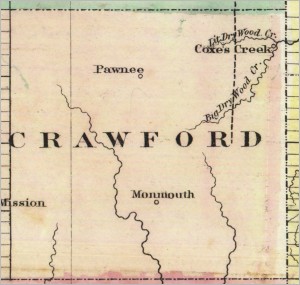Crawford County, Kansas

- Formed: March 30, 1855
- County Population 1870: 8,160
Image courtesy of Wichita State University Special Collections
Crawford County was originally part of the Cherokee Neutral Lands, land set aside for the Cherokee Nation to live after they were moved from their traditional homelands in the southeast. However, the land was officially ceded to the United States in the late 1860s. White settlement in the area began around the year 1850, although these people technically settled illegally. John Leman, a blacksmith, settled in the area in 1848. He remained until 1861 when the United States Army forced him to leave. The first permanent settler was a man named Mr. Sears. Another early settler was named Harden Matthews. Settlers were attracted to the area’s fresh water creeks, coal deposits and fertile soil.
In 1861, before the war began, President Buchanan ordered that all white settlers who settled in the area illegally be removed; since the lands were still legally the property of the Cherokee tribe. The United States Army burned many homes in the county in order to for exhile. There were no battles in the Crawford County boundaries, though there were several skirmishes with bushwhackers from Missouri under Colonel Thomas R. Livingston and Union troops in the area. Men from the Crawford County area enlisted in the 19th Kansas Regiment. The population of the county area, however, rose during the war due to people fleeing from more densely populated areas.
After the war concluded, the settlers began to rebuild their lives. Crawford County was officially established on February 13, 1867. It was named after Governor Samuel J. Crawford, who served as the Kansas Governor and then resigned to fight in the Civil War. Nine townships were established including: Walnut, Sherman, Washington, Baker, Sheridan, Lincoln, Grant, Osage, and Crawford. The county seat was named Crawfordsville. In the same year the county was established, several mining groups from Missouri came to the county to open up a commercial coal mine.
The early years of the county were dominated by debates over whether or not the railroad should be allowed to build in the county. Eventually, the railroad faction won out and the railroad began construction a few years after the county’s formation. Girard, a railroad town, soon became prosperous. The settlers soon debated what should be the new location of the county seat, as Crawfordsville was only meant to be temporary. They debated between Girard, a town called Rossville, and the actual geographical center of the county. Girard won, and was soon named the county seat. Another railroad town, New Pittsburg, was established in 1876 and grew to prominence soon after.
 Browse all collections in Crawford County
Browse all collections in Crawford County
- Consulted:
- http://skyways.lib.ks.us/counties/CR/
- William G. Cutler, History of the State of Kansas (Chicago: A.T. Andreas 1883). Accessed through:
- http://www.kancoll.org/books/cutler/crawford/crawford-co-p1.html
- Frank W. Blackman, Ed., Kansas: A Cyclopedia of State History, Embracing Events, Institutions, Industries, Counties, Cities, Towns, Prominent Persons, etc. (Standard Publishing Company, 1912) Accessed through:
- http://skyways.lib.ks.us/genweb/arcvhives/1912/c/crawford_county.html
- http://www.kshs.org/genealogists/places/counties.php?county=CR
- http://www.genuinekansas.com/county_crawford_county_kansas.htm












